Skills for Care is the leading source of workforce intelligence for adult social care in England.
In a new blog for the Homecare Association they look at what their data tells us about turnover rates in homecare.
Nationally, across all adult social care settings in England, the average turnover rate is 29%. For the homecare sector this is higher at 31.1%.
The data highlights associations between different variables – such as age and experience – and turnover rate. These variables are not necessarily the cause for workers leaving but the data can provide interesting insight.
Age
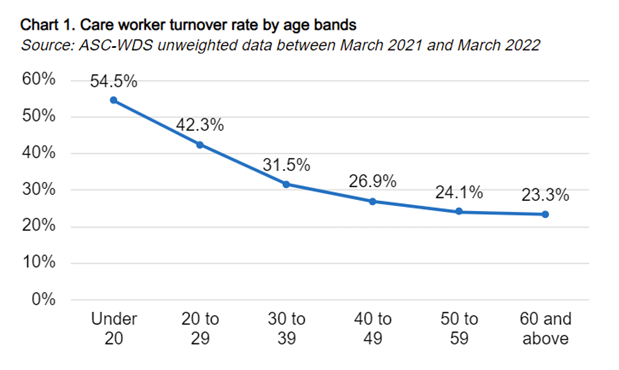
The average age of people working in social care is 45. For homecare this is similar at 44.
Turnover rates are highest among homecare workers aged under 20 years old, at 54.5%. This rate decreases as the age of the worker increases.
This follows the same trend as the national picture, where turnover is higher in younger workers than older workers. The difference in turnover rate between the lowest and highest age bands is larger in homecare than all adult social care settings.
Reasons for higher turnover of younger workers could be that care work is a ‘stopgap’ while studying or waiting for a vacancy in their preferred sector. Typically, younger workers are more likely to be in lower-paid roles, which is also an influencing factor of higher turnover rates. Some younger people could also be taking adult social care jobs due to a lack of choices, and subsequently don’t remain in the sector long-term.
There are many national and local recruitment initiatives aimed at young people, highlighting the benefits of a career in social care and challenging common misconceptions.
Experience in social care
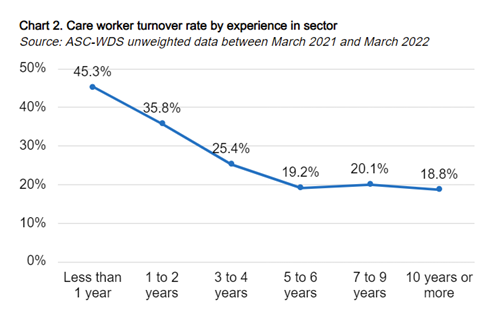
Workers with less experience in the adult social care sector are more likely to leave their posts than those with more experience.
Again, the gap is bigger in homecare. The turnover rate for people with less than one year of experience in social care is 45.3%. While for those with 10 or more years’ experience it’s 18.8%. This compares to 43.7% and 20.4% across adult social care settings.
One anomaly in homecare is that workers with seven to nine years’ experience have a higher turnover than those with five to six years’ experience.
Experience in current role
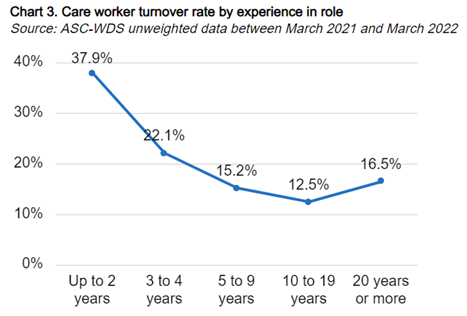
When looking at experience in their current role, the turnover rate is 37.9% for those with up to 2 years’ experience in the role. This rate dropped substantially for more experienced workers, to 12.5% for those with 10-19 years’ experience in the role. The rate is higher (16.5%) for those who’ve been in their role for 20 years or more, but this may be explained by people in this bracket retiring.
This is a similar trend to the national picture, where people with more experience in a role are generally less likely to leave.
Pay
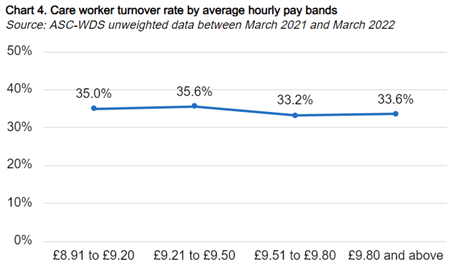
Workers at the top end of the hourly pay scale have a lower turnover rate than those at the bottom of the scale. This means that people who are paid more are less likely to leave their roles.
However, the trend has become less pronounced in more recent years. This is potentially due to the impact of the National Living Wage (NLW). Employers have had to increase pay for the lowest paid employees in line with the NLW, but they may not be able to afford to increase pay for higher paid care workers at the same rate. Therefore, the gap between the lowest and highest paid carers is reducing.
In homecare, the trend isn’t as clear as it is across all adult social care settings, which shows a gradual decrease in turnover rate from the lowest pay scales to the highest.
Training and qualifications
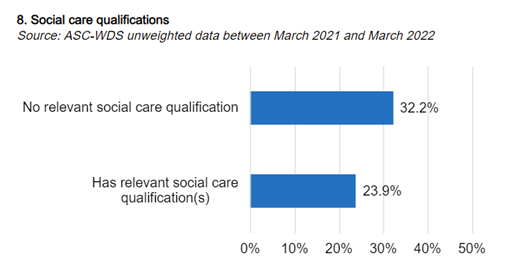
Homecare workers with a relevant social care qualification are less likely to leave, with a turnover rate of 23.9% for those with a qualification compared to 32.2% for those without. Across ASC, the trend is the same.
A similar trend appears for care workers that had undertaken a higher number of training courses. This suggests that employers investing more in the training and development of their staff generally experience lower turnover rates.
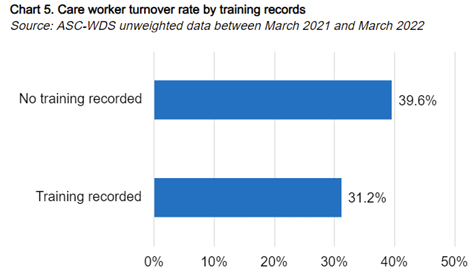
The average turnover rate is lower amongst homecare workers that had received some form of training (31.2%), compared to those that hadn’t (39.6%). This shows that retention is better when staff received training.
The difference isn’t as big across all adult social care settings, where the turnover rate is 31.7% for ‘training recorded’ and 41.2% for ‘no training record’.
Hours
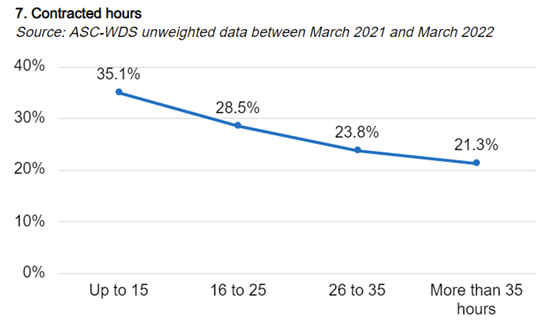
Workers with fewer contracted hours are more likely to leave, with a turnover rate of 35.1% for those with up to 15 contracted hours compared to 21.3% for those with more than 35 hours.
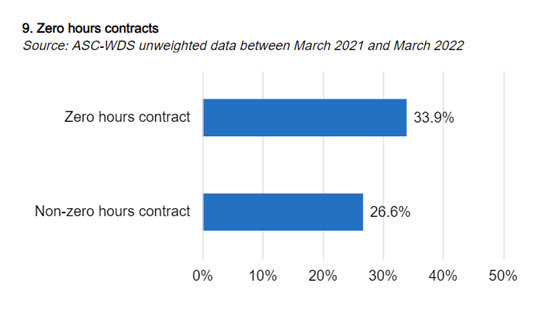
Zero-hours contracts had a slightly greater impact on turnover rate across adult social care, where the rate is 41.7% for those on zero-hour contracts compared to 32.6% for those not on zero-hours contracts.
However, the difference is also seen in homecare in which zero-hours contracts are more prevalent, with a turnover rate of 33.9% for those on zero-hours contracts compared to 26.6% for those on non-zero hours contracts.
The intelligence in this column is produced using data from the Adult Social Care Workforce Data Set (ASC-WDS). By using the ASC-WDS service, care providers help to shape policies and planning in the sector.
ASC-WDS also provides many benefits for providers. You can access funding for staff development, manage your staff and training records, benchmark your organisation against similar providers and claim discounts and special offers from Skills for Care and partners.
Find out more and sign up here: https://www.skillsforcare.org.uk/ASCWD






